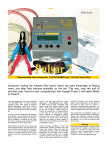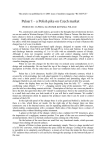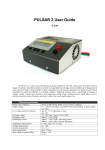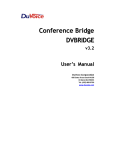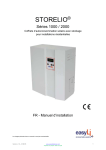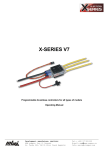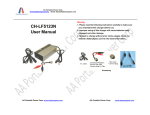Download Test Pulsar 2
Transcript
Pulsar 2 – multipurpose charger Test 9/2006 RC - Przegląd Modelarski After few emails and phone calls I've got Pulsar 2 in my hands. I need to say, that I've Pulsar 1 (which I like very much) since few years. This made me more curious, what Pulsar 2 will show. There's a sticker saying „version 2”. Except that detail, both Pulsar's are identical (Pic.1) After careful inspection I've found few other differences like different cover finish, smoother edges, thicker cables and little bit different clamps with small cutout in the front making them easier to put on the power supply. Pulsar 2 isn't a large device. It measures 130x120x60mm (5.1x4.7x2.3 inch) and weights 890g (ab. 2 lbs). It makes it easier to put into modeler's tool box. Top cover contains 2 row, 16 position LCD display with enlightens, 4 buttons below and battery connection socket on the right. On the left side, an RS232, cooling fan and temperature sensor sockets are installed (Pic. 2). On the right side (Pic. 3) you'll find a clean, laser cut internal fan exit. Inside of charger looks very professional too (Pic. 4): Clean components placement, large heat sink, big, step up-step down voltage converter coil. What's inside? What it can do? - Pulsar 2 charger − RS232 cable for PC connection − printed user manual − CD with software and colorful, multilanguage manuals − temperature sensor (with neodymium magnet to make installation on the pack easier) It can do a lot. A list of features is very impressive: − 1 to 32 Ni-Cd/Ni-MH cells − 1 to 12 Li-xxx cells − power supply voltage 10-16V DC (min. 30Ah car battery 70Ah recommended or mains power supply 14V with min. 5A – recommended 30A) − max. charging current: 9.9A − max. power: 250W − max. discharging current: 9.9A (up to 250W when Reverse On the beginning, there were nickel and cadmium. After that, NiMH and other types became real. Today, a lot of many battery types exist on the market. How to charge them? For most home applications, any ordinary charger can be used. What about so specialized and demanding applications (like RC modeling)? The choice isn't easy. To meet modeler's needs, many manufacturers have created their multi purpose devices. Mostly, these were from the Western countries. Not so long time ago, a few Polish manufacturers introduced their chargers. One of them is Pulsar 2 manufactured by Elprog Company from Rzeszów. Company founder and chargers designer is Sławomir Krymski. − − − − − mode used – return of energy to the car battery) Reflex mode for charging Inflex mode (charging will be interrupted before battery will be overcharged) Fast mode (for Li-Ion, Li-Pol and Pb up to 9.9A for Pb, RAM, Li-Ion, Li-Pol and Li-Manganoxid (tadiran) cells charging voltage can be adjusted down ab. 0.2V with 10mV steps battery's internal resistance measuring (Ri) for comparison purposes (up to 4A of control current) Pic. 2 First look on Pulsar 2 and.... hey, come on! I've had to receive Pulsar 2, not Pulsar 1... Luckily, it was just an illusion. Pic. 1 Pic. 4 Pic. 3 − − Pic. 5 Pic. 6 Pic. 7 Pic. 8 LCD backlight internal cooling fan with smooth speed control Pulsar can work with many battery types like: Ni-Cd, Ni-MH, Li-Ion, LiPol, Li-Ta, Pb-bar, RAM (at the moment this review was written, I've got info from Elprog, that Li-FePO4 support was added). Just after charger is switched on, you can set general parameters using „M” button (Pic.5) like sound alert, Tmax (controlling of max. temperature of the battery), T-on – max. battery temperature for start of charging (30-45°C – charger will wait for battery cool down to adjusted temp.), T-off – stop charging temperature (50 - 65°C) and V-off – power supply voltage below which charging will be stopped (10-11.5V). „E” button starts a work modes, +/- buttons are used to select one of eight program memories (freely adjustable) or one of two special programs (Format/Regeneration). There's also possible display of last, eight processes (Pic. 6). User manual Pic. 9 Pic.10 Pic. 11 − − − − − cells format up to 4A (with user switchable „Regeneration” function) Car's battery overcharging protection (when Reverse function is used) Too low car's battery voltage threshold (adjusted between 10 and 11.5V) wrong polarity protection external cooling fan socket is short circuit protected At first glance it looks bit complicated, because so many features are controlled by only 4 buttons. However, after reading of 12 page manual you'll be able to freely use of all options and parameters. In short: Choose what you want to do („M” button), how you want to do it („E” button) and change values using +/- buttons. The manual is divided according to charger's functions (charging, discharging etc.). There are diagrams describing all functions and possible parameters. There's a nice surprise at the end of this tiny book: sample, step by step description of programming process. How does it work? Let's get to the practice. There are few tools available for the user like: charging Ni-Xx, charging Li-Xx, LiTa, Pb, RAM, discharging, discharging and charging, format (with regeneration function), cells test. Ni-Xx charging can be done in Delta peak/Inflex/Reflex modes. Although you'll find Delta peak mode in almost all chargers on the market, you'll not find the last two: Reflex and Inflex. They're not so frequently found in chargers (the second one probably isn't used anywhere else at all). Inflex charging is a fast charging mode, however, there's no possibility of overcharging (as it exist in normal, ΔP mode). Charging will be stopped at the point of biggest voltage increment (just before battery pack is fully charged). It avoids too high battery warming. In Reflex mode, there's a short discharging (balancing) impulse added. It helps to avoid so called memory effect (you can say after manual „Reflex – always gives a profits”). Here's how the sample charging process looks like: Choose charging mode (Pic.7), cell type (Pic.8), switch Inflex mode on (Pic.9), add Reflex mode (Pic.10), as manual suggests, set Delta to low (Pic. 11) and charging current (Pic.12). Now, connect the battery, adjust cells number if needed (Pic. 13) and start the charging. Of course, you don't need to do that every time you want to charge the same cells type or with the same parameters. Next time, you'll just select that program with all previous settings and connect the battery. During the charging process, following information are displayed: „C” - charging, number of cells, charging current, actual charging voltage, raise/drop of voltage (an arrow), power supply voltage, battery temperature (Pic.14) and process time and energy received by battery (Pic. 15). For the remaining cell types (Li-Xx, Pb, RAM etc.) we can choose following model: Fast, Reflex, V-end. The Fast mode is a pulse charge mode which makes charging time over two times shorter. V-end mode let the user set the final voltage to which battery has to be charged. Discharging let's you discharge cells to their threshold voltage, which is predefined for each type of cell: NiXx 0.9V, Pb 1.8V, RAM 1V, Li-Ion 2.7V, Li-Pol 3V, Li-Ta 2.4V. Discharging will be stopped after battery voltage drops to the threshold value. In the Auto mode, current will be decreased by ¼ each time voltage drops to threshold value. Entire process will be finished when discharging current drops to 200mA. Reverse is a very interesting function Pic. 12 Pic. 13 Pic. 14 Measuring of internal resistance has to be meant as a comparison measuring of different packs. Measuring gas to be done using the same cord and current has to be set to close of 1C (where C is a capacity of a battery pack). In each mode, charger is waiting for confirmation of the number of cells (to correct automatically recognized number of cells). After that, Pulsar starts the program. In the case of charging, Pulsar doesn't use, max, adjusted current, but is increasing it slowly in period of one minute (user can skip „slow start” by pressing „+”). Another useful function is „forced start”. It let's to charge battery packs in the transmitters, where input is protected by diode (like Graupner or Hitec), so user don't need to remove pack each time it's being charged. In this mode, Reflex is switched off and max. recommended (according to the manual) current is 1.2A which is caused by wire thickness in these packs. Pic. 16 Pic. 17 Pic.18 Software Pic. 15 in discharging mode. Energy from discharged battery is directed to the car battery powering Pulsar 2 (of course, Reverse has to be switched off when mains power supply is used). At the same time, car battery is protected against overcharging when using Reverse. Another very essential and useful tool is Format/Regeneration. Format is a loop of few cycles (1 to 8) of discharge/charge processes. Discharging is done automatically until threshold voltage (proper for each type of cell) is reached. Thanks to that, we don't have to „watch” on new packs to discharge them fully and then fully charge etc. Pulsar 2 will do that for us. Regeneration is a special mode for formatting used battery backs. It can repair „bad” battery pack (balancing etc.). You'll find it ... only in Pulsar 2! The last tool of Pulsar2 is Test. It lets you measure of internal resistance of the battery pack or single cells. Test is performed in 3 stages: - precise voltage measuring - measuring of voltage under load of adjusted current (for 10s) - measuring of internal resistance of the battery pack The CD mentioned on earlier, contains PCGraph software used for visualization and managing of processes results. It can clearly show graphs of voltage, current, temperature, voltage increase in mV/min (Pic. 16 - 18). For comparison, you can put few graphs on the screen together. In addition: results can be shown on a column graphs. You can change display mode to show single cell or full pack result. Graphs can be freely scaled. Summary After few months using Pulsar 2 I can honestly say, that except few small details (like non protected cooling cut-outs, which makes it more difficult to use open air, or at the beginning, a little bit difficult usage) Pulsar 2 is a really great device, which can be used not only by the modelers. I've used it many times to charge other than RC packs like single cells for my digital camera (I've „invented” a special accessory to do that – Pic. 19), but is recommended to not exceed 1A of current when using that. I've been experimenting with unusual battery packs like video camera pack (it required some „combinations”). Very valuable feature is possibility of Pic. 19 Pic. 20 firmware upgrade. However, to do that, Pulsar 2 has to be send to manufacturer. Additional recommendation can be fact, that this device has been rewarded with many, prestigious awards like „Golden Euro” in the category of „Product with the future 2006” (Pic.20) and have „conquested” Western markets, where competition is much stronger than on domestic ground. Text and pictures: MAREK SZULEN



